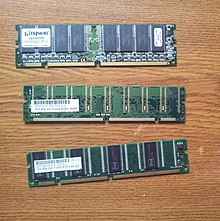
Back ذاكرة وصول عشوائية حركية متزامنة Arabic SDRAM Azerbaijani SDRAM Catalan Synchronous Dynamic Random Access Memory German SDRAM Spanish SDRAM Estonian SDRAM Basque SDRAM Finnish SDRAM French SDRAM HE
| Computer memory and data storage types |
|---|
| Volatile |
| Non-volatile |

Synchronous dynamic random-access memory (synchronous dynamic RAM or SDRAM) is any DRAM where the operation of its external pin interface is coordinated by an externally supplied clock signal.
DRAM integrated circuits (ICs) produced from the early 1970s to the early 1990s used an asynchronous interface, in which input control signals have a direct effect on internal functions delayed only by the trip across its semiconductor pathways. SDRAM has a synchronous interface, whereby changes on control inputs are recognised after a rising edge of its clock input. In SDRAM families standardized by JEDEC, the clock signal controls the stepping of an internal finite-state machine that responds to incoming commands. These commands can be pipelined to improve performance, with previously started operations completing while new commands are received. The memory is divided into several equally sized but independent sections called banks, allowing the device to operate on a memory access command in each bank simultaneously and speed up access in an interleaved fashion. This allows SDRAMs to achieve greater concurrency and higher data transfer rates than asynchronous DRAMs could.
Pipelining means that the chip can accept a new command before it has finished processing the previous one. For a pipelined write, the write command can be immediately followed by another command without waiting for the data to be written into the memory array. For a pipelined read, the requested data appears a fixed number of clock cycles (latency) after the read command, during which additional commands can be sent.